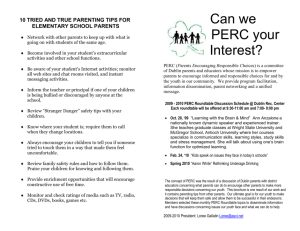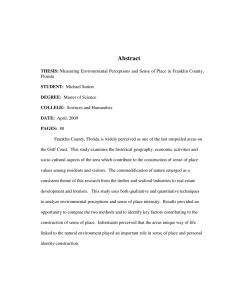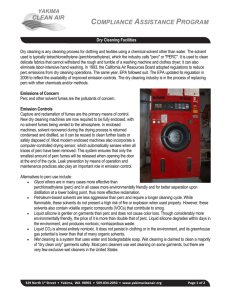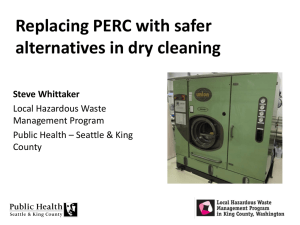NJ Department of Environmental Protection and Energy
advertisement
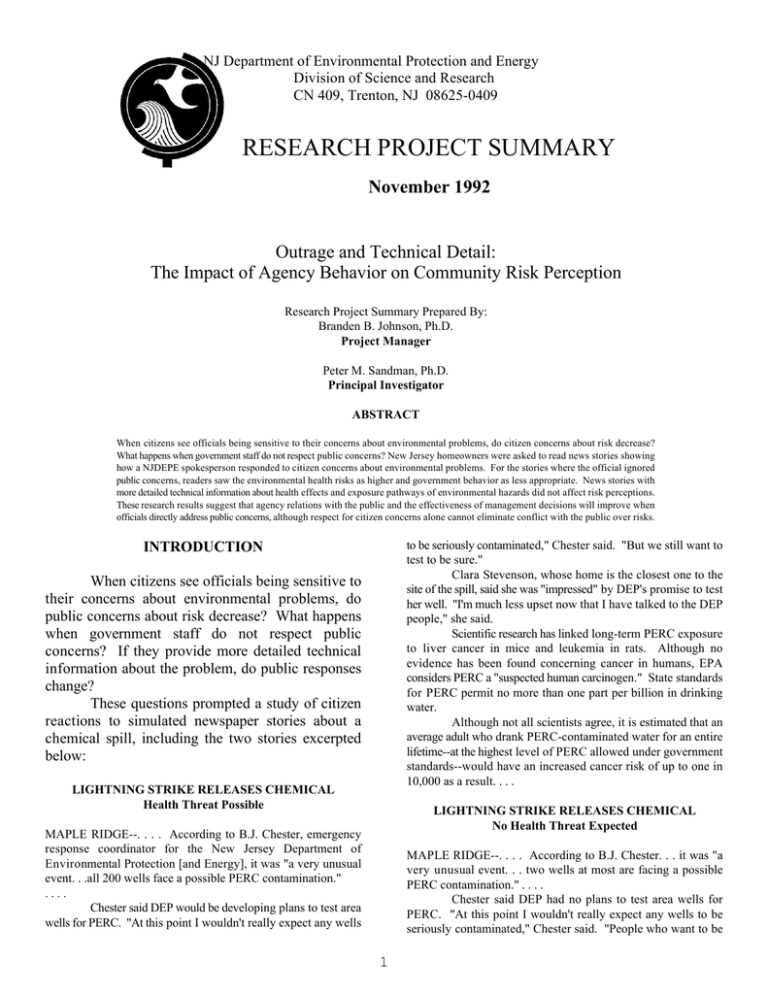
NJ Department of Environmental Protection and Energy Division of Science and Research CN 409, Trenton, NJ 08625-0409 RESEARCH PROJECT SUMMARY November 1992 Outrage and Technical Detail: The Impact of Agency Behavior on Community Risk Perception Research Project Summary Prepared By: Branden B. Johnson, Ph.D. Project Manager Peter M. Sandman, Ph.D. Principal Investigator ABSTRACT When citizens see officials being sensitive to their concerns about environmental problems, do citizen concerns about risk decrease? What happens when government staff do not respect public concerns? New Jersey homeowners were asked to read news stories showing how a NJDEPE spokesperson responded to citizen concerns about environmental problems. For the stories where the official ignored public concerns, readers saw the environmental health risks as higher and government behavior as less appropriate. News stories with more detailed technical information about health effects and exposure pathways of environmental hazards did not affect risk perceptions. These research results suggest that agency relations with the public and the effectiveness of management decisions will improve when officials directly address public concerns, although respect for citizen concerns alone cannot eliminate conflict with the public over risks. to be seriously contaminated," Chester said. "But we still want to test to be sure." Clara Stevenson, whose home is the closest one to the site of the spill, said she was "impressed" by DEP's promise to test her well. "I'm much less upset now that I have talked to the DEP people," she said. Scientific research has linked long-term PERC exposure to liver cancer in mice and leukemia in rats. Although no evidence has been found concerning cancer in humans, EPA considers PERC a "suspected human carcinogen." State standards for PERC permit no more than one part per billion in drinking water. Although not all scientists agree, it is estimated that an average adult who drank PERC-contaminated water for an entire lifetime--at the highest level of PERC allowed under government standards--would have an increased cancer risk of up to one in 10,000 as a result. . . . INTRODUCTION When citizens see officials being sensitive to their concerns about environmental problems, do public concerns about risk decrease? What happens when government staff do not respect public concerns? If they provide more detailed technical information about the problem, do public responses change? These questions prompted a study of citizen reactions to simulated newspaper stories about a chemical spill, including the two stories excerpted below: LIGHTNING STRIKE RELEASES CHEMICAL Health Threat Possible LIGHTNING STRIKE RELEASES CHEMICAL No Health Threat Expected MAPLE RIDGE--. . . . According to B.J. Chester, emergency response coordinator for the New Jersey Department of Environmental Protection [and Energy], it was "a very unusual event. . .all 200 wells face a possible PERC contamination." .... Chester said DEP would be developing plans to test area wells for PERC. "At this point I wouldn't really expect any wells MAPLE RIDGE--. . . . According to B.J. Chester. . . it was "a very unusual event. . . two wells at most are facing a possible PERC contamination." . . . . Chester said DEP had no plans to test area wells for PERC. "At this point I wouldn't really expect any wells to be seriously contaminated," Chester said. "People who want to be 1 sure will have to make their own arrangements." Clara Stevenson . . . said she was "furious" about DEP's unwillingness to test her well. "My whole family is upset and the DEP people just don't seem to care," she said. Scientific research has linked . . . . Although not all scientists agree, . . . an increased cancer risk of up to one in a million as a result. risk. Story Variations STORY STUDY RATIONALE If you lived in this community, which story would make you feel more concerned about the environmental risks? This is the question researchers at NJDEPE and Rutgers set out to answer in a study of how citizens perceive risks and government performance in dealing with environmental problems. The excerpts you just read were from two versions of a simulated news story about a hypothetical environmental problem used to find out how New Jersey citizens answer these questions. They illustrate a very real problem facing public risk managers. They need to know how citizens construct their perceptions of risk. Experts and citizens have long disagreed over which risks to human health and the environment are more important. This conflict increases the cost of environmental management, and may result in less protection of health and the environment as well. What is the origin of this conflict? One explanation is that citizens do not know important technical facts. The solution is public education about the toxicity, exposure routes, and health effects of chemicals. A competing explanation is that citizens see officials as untrustworthy and unfair. In this view the solution to conflict is for regulators to address citizen concerns. Since no experimental research has compared the validity of these explanations, this research intended to test these competing views and provide guidance to government on dealing more effectively with the public. OUTRAGE DETAIL RISK 1 Low Low Low 2 Low Low High 3 Low High Low 4 High Low Low 5 High High Low Technical detail varied the amount of facts given about health effects, the evidence for those health effects, and exposure pathways. Real newspaper stories about the environment carry relatively little technical information. Highly detailed stories in this study gave no more detail than it was plausible for highly detailed news stories to have in real newspapers. LOW DETAIL: "Scientific research has linked long-term PERC exposure to some kinds of cancer in test animals" HIGH DETAIL: "Scientific research has linked long-term PERC exposure to liver cancer in mice and leukemia in rats. Although no evidence has been found concerning cancer in humans, EPA considers PERC a 'suspected human carcinogen.'" Outrage varied the agency spokesperson's willingness to share information, promise review of regulations, and arrange for wellwater and exposure testing. Reported levels of residents' outrage also were varied. LOW OUTRAGE: "'We will certainly want to take another look at the regulations.... Perhaps the agency should consider tougher standards for lightning protection.'" RESEARCH DESIGN Researchers developed simulated news stories about a spill of perchloroethylene (PERC). The study used a news story format because the mass media are widely used by officials to disseminate environmental information. Five versions of the news story were read and responded to by 595 middle-class homeowners in New Jersey, one version by each person. The stories combined "low" or "high" values of three treatment variables: technical detail, outrage and the size of the 2 HIGH OUTRAGE: "'It looks like a fluke it behaves satisfactorily in other ways. Perceived detail correlated with perceived risk, as if detailed explanations (although not consciously observed) were experienced as a cue that the risk must be serious. High-outrage stories made people see the risk as much more serious and worrisome than lowoutrage stories, although without affecting people's "intention to test" well water. When agency behavior seems unresponsive and the agency-community relationship poor, people tend to judge the risk as more serious even if they do not do more about it themselves. They also see the agency as managing the hazard less appropriately. Subjects who read the high-risk story considered the risk only slightly more serious than those who read the comparable low-risk story, and felt the agency was responding less appropriately. Other risk perception variables were not affected by the size of the risk. Because risk magnitude had a strong effect on responses to factual questions about concentration, exposure and the like, it is clear that the subjects understood what they were told about the risk's size. Their own assessments of seriousness, however, reflected other factors more strongly. In general, societal risk aversion was tied to worrying about the risk and considering it serious, while personal risk aversion was tied to intentions to test. Neither kind of risk aversion is readily amenable to agency influence. Better-educated people tended to see the risk as lower, but were more likely to test their well water. Women saw risk as higher. Overall, all of the factors tested together accounted for only about 10% of the variance of perceived risk, and only 5% for intention to test wellwater. In other words, many factors other than those measured clearly influenced citizens' perceptions of risk and government responsiveness. to me.... As far as I know, DEP has no plans to re-examine the regulations. You can't cover every conceivable event.'" Risk magnitude was varied so that the low risk scenario was about 800,000 times lower overall than the high risk version of the news story. This variable included the estimated toxicity of PERC, the estimated exposures resulting from the spill, the number of people exposed, and how far the spill was from the nearest household. For example, either two or 200 household wells were potentially exposed to PERC contamination. Each study participant also answered questions about some personal attributes that might affect their reactions to these stories. Their willingness to take risks, whether in personal life or in societal decisions, might affect their reactions. They were asked how much they agreed, for example, with the statements that "The public has the right to demand zero pollution from industry" (societal) and "I try to avoid all food additives and preservatives" (personal). Questions were also asked about people's age, gender, and education. Three kinds of responses to the hazard were measured, to see how the different stories might affect them. These included perceptions of risk; perceptions of how appropriately government responded to the PERC spill; and how willing people would be to pay $500 to test their well water if they lived in the area. RESULTS Differences in amount of technical detail provided in stories did not affect either perceived risk or people's intention to test well water. Citizens and experts did not agree on differences in detail across the stories. In pretests those who read specific highdetail paragraphs saw much more detail about potential health effects than those who read low-detail paragraphs. There was a wide variation in perceived detail as well, and agency experts saw a substantial difference in the amount of technical detail in the stories. Given these findings, this difference between perceived detail for citizens and for experts seems to be real rather than due to problems with how the research was done. Interestingly, subjects who read low-outrage stories or who saw the agency response as more appropriate were more likely to see the stories as detailed. This suggests that people are more apt to see the agency as providing enough information when DISCUSSION This study provides the first evidence that how an agency behaves (or is reported to behave) is at least as critical for public perceptions of risk and agency performance as what it says. The effect of outrage on risk perception and perceived appropriateness of agency behavior far outweighed the modest effects of an 800,000-fold difference in the size of the risks. This is even truer comparing the strong effects of outrage to the non-observed effects of technical detail. In fact, outrage and perceived detail were more strongly correlated than were 3 technical detail and perceived detail. This is not, however, the same as saying that transmission of technical information has no effect. Science is as important in environmental policy as having an open decision process. Educating the public on technical information may have an effect on perceived risk and perceived appropriateness of agency behavior in other circumstances. For example, newspapers may not be as effective a tool for such education as television, and personal interaction--such as in a small group meeting or public meeting--may be even more effective. The effect of different kinds of technical information also should be explored in further research. The findings suggest that conflict with the public can be reduced when agency staff demonstrate respect for citizen concerns. However, this is only one factor in the larger context of risk decisionmaking, and alone cannot eliminate conflict with the public over risks. This study found personal beliefs about avoiding risk also had strong effects on perceived risk and willingness to test one's own well water. Therefore government behavior can reduce but not stop conflict. FUNDING SOURCE This work was funded by Office of Environmental Health Assessment funds of the Division of Science and Research (DSR) under Contract C29714. ADDITIONAL INFORMATION Copies of the Final Report for this project are available from DSR (609-292-1088). A fee to cover the cost of reproduction may be charged. For general information about environmental research conducted and supported by DSR, call 609-984-6070, or write to the address on the first page of this summary. DSR Reference No. 92005. ACKNOWLEDGEMENTS Dr. Branden Johnson is a Research Scientist in the Bureau of Risk Communication and Risk Reduction in DSR. Dr. Peter Sandman is Professor of Environmental Journalism at Cook College, and (at the time of the research) Director of the Environmental Communication Research Program (ECRP), at Rutgers University. Dr. Paul Miller, an ECRP Research Associate during the study, collaborated on the research. CONCLUSION Many agency managers, corporate executives and academic experts feel that giving citizens more detail about health effects data and likely exposure routes would reduce their concerns. This study suggests that may not be the most appropriate avenue to pursue. Both agency process and science are important in shaping public responses to risks. Yet officials who try to educate citizens on technical issues without also considering changes in how they deal with citizens overall may do themselves a disservice. They should swiftly inform citizens how they are dealing with a problem, and address public concerns. Further efforts to explore the role of technical information on the other dimensions suggested above would be valuable to confirm how institutions can best address public concerns and needs for environmental education. These results have been shared with audiences inside and outside the New Jersey Department of Environmental Protection and Energy, in hopes that they would prove useful to managers of environmental problems. 4

